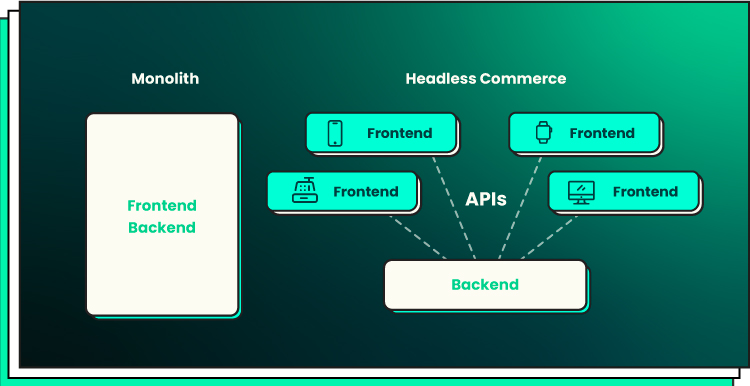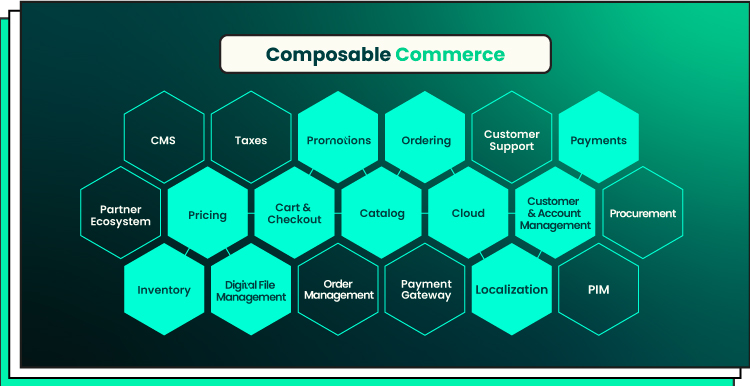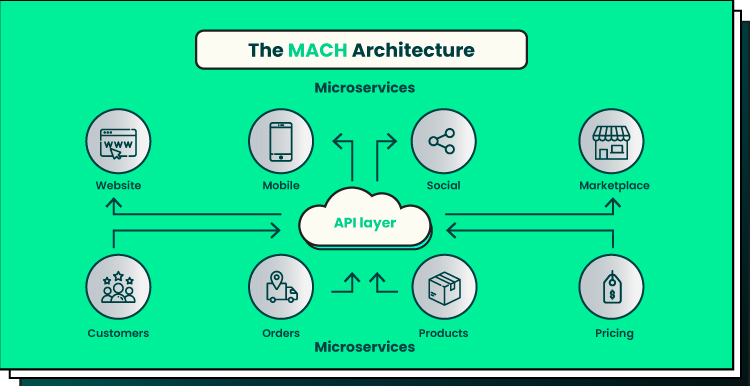When you start your ecommerce business, it may be difficult for you to choose what path and what ecommerce model to take. You may opt for a traditional business model and choose a one-size-fits-all solution. Out-of-the-box commerce platforms offer the features needed for building an ecommerce website from scratch.
But as you grow, the needs of your ecommerce brand become more uncommon and diverse. At this point, you realize that using a traditional ecommerce platform is not enough for you to scale. That’s when the idea of headless commerce or composable commerce may come to your head.
In this article, we will talk about headless commerce and compare it to composable commerce. We’ll also try to help you choose the right approach to let your online business grow.
Backstory of Headless Commerce Growth
Back in time, online commerce started gaining popularity. Many traditional businesses began to establish a separate online sale funnel in addition to the offline. As new technologies and digital commerce grew, the importance of online user experience also increased. But despite their effort, retailers lagged behind these changes. They leveraged limited toolsets for doing commerce online. Businesses typically used an all-in-one platform and a monolithic architecture for running ecommerce websites. This limited their growth opportunities and led to a lack of agility. Besides, this approach gave companies little visibility of online shopping trends and the changes in consumer behavior.
And here is why. Under the monolithic approach, an ecommerce site operates as a single solution. Once you want to modify some of the modules on your site, like the product catalog or shopping cart, you should modify the whole code base. Over time, you keep improving your code and adding some new features to it. As a result, you get a single massive code base that is hard to maintain and support.
The use of a traditional commerce platform gives no flexibility. It also adversely affects the site’s performance. This is why the monolithic approach quickly became a thing of the past. eCommerce brands and software engineers looked for a solution that would give them more scalability and freedom of choice.
At some point, retailers invented a way to adjust to the rapidly changing market dynamics. They started separating their front-end presentation layer from back-end processes. Ecommerce business owners expected this change to help them bridge the gap between offline and online. While having a solid back end accessed via APIs, they could manipulate their front-end processes and separate customer experience from the core services. And this was what we now call headless architecture.

What Is Headless Commerce?
The headless commerce market is rapidly growing — its funding reached $1.6 billion. A big part of the funding is devoted to building and improving headless CMS systems. But what makes a headless commerce solution so special? Let’s figure it out.
We’ll start with the “headless commerce” definition. Headless commerce is decoupling complicated back-end operations that are business-centered from the flexible front-end presentation layer that is client-centered. The front-end part of an e-commerce system is represented by the user interface that includes components and elements customers interact with. For example, buttons, bulk actions, links, content, and more. To write the front end of the headless commerce platforms, software engineers leverage modern frameworks like Angular JS, React JS, and others.

Meanwhile, the back end lies at the core of each website. It is like the backbone of an e-commerce business. The backend system of a commerce website handles requests and consists of data storage, a server, and other components that are invisible to the end user. When a customer clicks on some button, the browser sends a request to the back end. With the help of the back end, the request is processed, and a user receives a response.
Note: Why are we talking about e-commerce solutions? Forbytes is a team of software engineering enthusiasts and tech experts. Since 2011, we have been building digital solutions for businesses of different sizes and niches. Our team specializes in solving business challenges with the help of the right technology stack and its best capabilities.
Contact us if you need help with e-commerce software development, headless e-commerce, site optimization, boosting security, or enhancing your digital solutions with new commerce functionality.
One of the headless commerce examples is its application in content management. Suppose that there is a business selling a wide range of products on several e-commerce sites. Each website requires a different approach to content management. Products on one site include detailed descriptions while products on another site are described more laconically. If a business uses a single content management system for all of its sites, it complicates the process of creating content and requires it to adjust all the sites to the system’s demands.
In contrast to this, the business can enjoy the benefits of headless commerce. By using headless solutions, they can develop multiple customizable content models that are connected to the core system via API and use them independently.
So, by choosing a headless tech stack, retailers get the independent frontend system for shaping digital user experience and the core backend system for enabling back-office processes and operations.
But there always are two sides of the same coin, and using a headless commerce system is no exception. Building headless commerce architecture with the help of one digital commerce platform was a challenging task. This approach gave retailers less flexibility and made it difficult for them to change their business models. It was hard for retailers to keep pace with online advancements and keep using traditional e-commerce platforms at the same time. What’s more, there was a growing demand for flexible services, like online pick-up in-store or subscription-based services. All these factors led to the growing need to invent a smarter and more flexible strategy. As a result, many businesses opted out of the headless commerce model not to depend on outdated all-in-one platforms.
What Is Composable Commerce?
Composable commerce took it one step further. According to Gurtner, businesses adopting composable commerce are 80% likely to outstand the competition when it comes to adding new features to their stores.
The term “composable commerce” was first used in the Gartner research back in June 2020. It denotes an innovative way of doing digital commerce. In a composable commerce platform, your e-commerce system contains multiple components united under the modular approach. Each of the components can be modified, scaled, or replaced at any time without damaging the entire system.
The components of composable commerce can be compared to LEGO bricks. You can use the bricks in any way you like and create a unique configuration or pattern. The same works with any composable commerce solution. It gives e-commerce businesses a lot of flexibility as they can adjust their digital system to the specifics of the online operations and consumer experiences. So, with composable architecture, online retailers reach the highest level of efficiency and optimization.

The foundation of composable commerce is the use of modules that are connected via API. Each of these modules targets specific business requirements.
Here are three main principles of how to build a robust composable commerce strategy:
1. Business-centric approach. You should manipulate your system’s components in a way that serves your business needs. The key benefit of the composable approach is that you are not obliged to adjust to the capacities of a platform. Instead, this is the platform that will be adjusted to your needs and goals.
2. Modular architecture. You need to build a modular commerce architecture that will give you flexibility and allow you to enjoy all the benefits of composable commerce. E-commerce microservices architecture means that you can manage all of your components, such as the content management system, payment options, and analytics, separately. The modular approach offers businesses the opportunity to change or improve one component without affecting the rest.
3. Keep your system open and flexible. You should keep your commerce ecosystem open and flexible to get essential support and maintenance services from your partnering company. Once you decide to scale your components up or add some new constituents to the system, your software development partner will do it for you or merge it with any solution of your choice.
MACH Architecture in Composable Commerce
Composable commerce grew as a response to changing customer expectations and the need for personalization. Here are the Big 4 of composable commerce that make up the so-called MACH architecture. MACH stands for:
- M – microservices
- A – API-first
- C – cloud-native
- H – headless
Microservices
Microservices are the building blocks of your decentralized architecture. Different parts of your website can be microservices and function independently from one another. For example, you can have an independent module for payment processing, shopping cart, checkout, product catalog, etc. Together, they will compose an effective microservices architecture that will be easy to manage and maintain.
API-first
Application programming interfaces (APIs) are like bridges between different software components of an ecommerce platform. Their role is to manage requests and deliver responses from the front end to the back end and vice versa. eCommerce APIs can also connect different systems to each other.
Cloud-native
As your business grows, it is harder for you to maintain physical databases and on-premises solutions. You have to manually control the performance, security, and effectiveness of the whole system. To get rid of this headache, choose a cloud-native architecture. Your partnering company will take care of all maintenance tasks while freeing your time for value-added tasks.
Headless
Headless e-commerce platforms form the ground for the growth of composable commerce. A distributed approach to maintaining your site will help you prevent website crashes and give you a lot of opportunities to improve your solution. Instead of relying on a single monolithic structure, you will be able to use headless technologies, add new features, and scale your solution up while offering a great omnichannel experience for end users.

Composable Commerce Benefits
Here are some of the main benefits a composable commerce can bring to your business and your daily operations:
Easier maintenance
Composable e-commerce environments are easy to maintain. Your team can sleep soundly without the fear that a change in one component will affect the whole system. Composable commerce lets each software engineer work consistently on their tasks and regularly improve the functionality of the solution. What’s more, the introduction of new features becomes hassle-free because your team will be able to expand the functionality without the fear of crashing the software.
Fewer expenses
Composable commerce cuts operating costs. For each component of your solution, you can choose the most efficient strategy without affecting the rest of the components. Many composable solutions work with low-code or no-code. This enables non-technical employees to perform a big part of maintenance tasks. This helps reduce the time and effort needed to maintain the system, which in turn positively affects your expenses.
Flexibility
Composable commerce enables brands to sell and promote their goods across many channels including a website, web app, mobile apps, social media pages, etc. With composable commerce, e-commerce businesses have enough freedom to deliver innovative experiences across different platforms in an engaging way. They also have the chance to modify the back end in a way it best serves their needs.
Modern approach
If you implement a composable commerce approach, you will be one step ahead of your competitors. You will scale comfortably and increase the number of users while continuing to improve your e-commerce product with no adverse effects on the system as a whole.
Headless Commerce vs. Composable Commerce
At first glance, it may seem that a headless e-commerce platform means the same as a composable commerce system. But in fact, these two terms are different and cannot be used interchangeably. The headless commerce approach grew from a traditional commerce platform where it was impossible to decouple elements in a system. In a headless solution, two parts of the system are decoupled and broken down into the front end and back end.
In contrast to a headless platform, composable architecture is a more complex notion consisting of multiple components that are brought together and can be configured independently in a customizable way. Composable commerce grew from headless commerce and presents a whole new level of doing business digitally. In other words, composable commerce enables online retailers to take each component independently and configure it in a way that serves their exact business requirements while not disrupting the whole system and the rest of the components.

Looking for Help with Headless or Composable Commerce?
In this article, we did our best to explain everything you should know about a headless e-commerce solution vs. composable commerce architecture and the way they differ from the traditional e-commerce model. As you see, both approaches are transformational in the context of online businesses. However, these two terms are different. Headless commerce means doing online commerce without a single centralized structure decoupling your system into the front end and back end. Composable commerce is a new stage of ecommerce development and means breaking your ecommerce system into multiple independent components that can be manipulated separately.
If you are determined to change your architecture from headless to composable, contact our team.
Forbytes is an experienced e-commerce development company. We help small to big businesses undergo digital transformation, automate their processes and operations, cut daily expenses by leveraging the power of modern technologies, and modernize their online stores to meet changing client demands. Together, we can set measurable goals for your business and help you achieve them with powerful headless commerce solutions.

Our Engineers
Can Help
Are you ready to discover all benefits of running a business in the digital era?

Our Engineers
Can Help
Are you ready to discover all benefits of running a business in the digital era?








